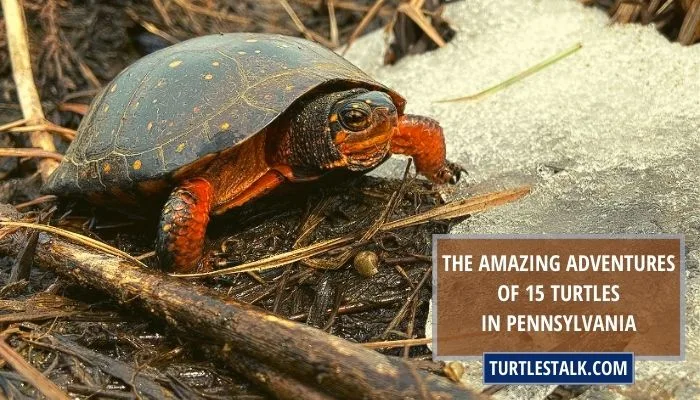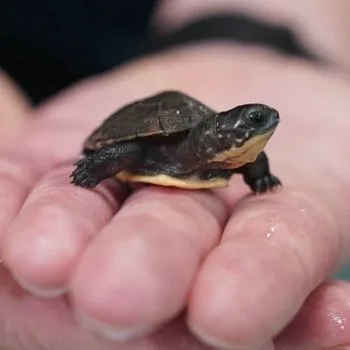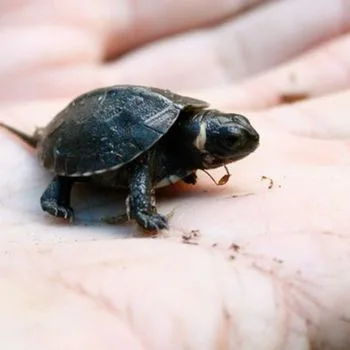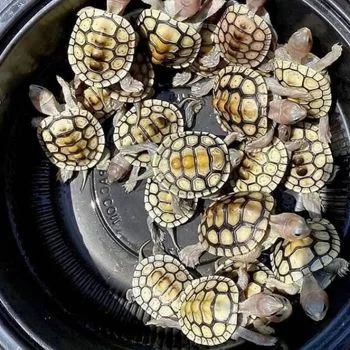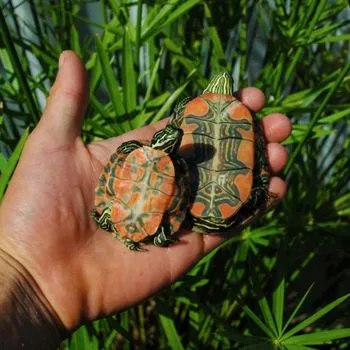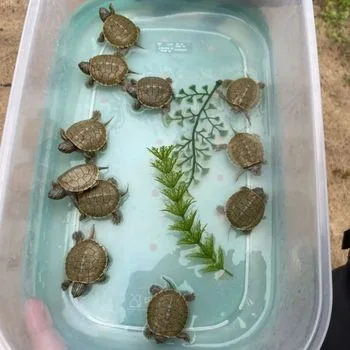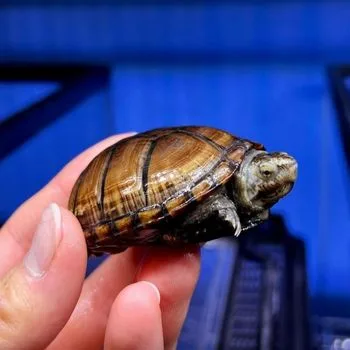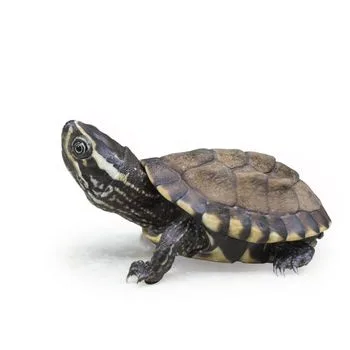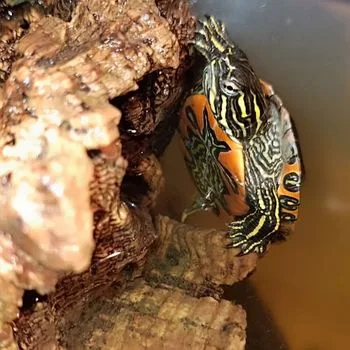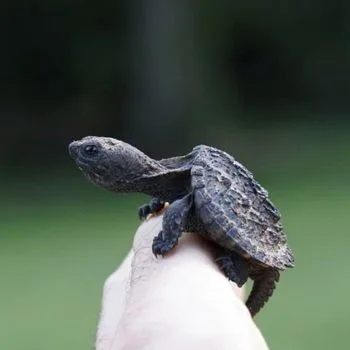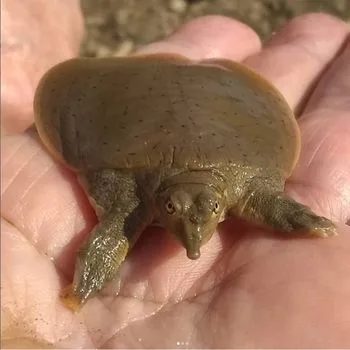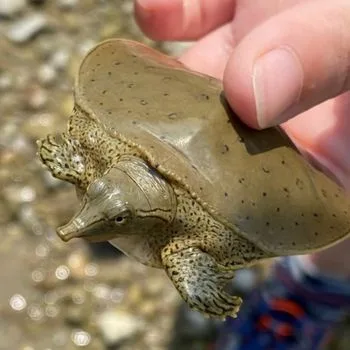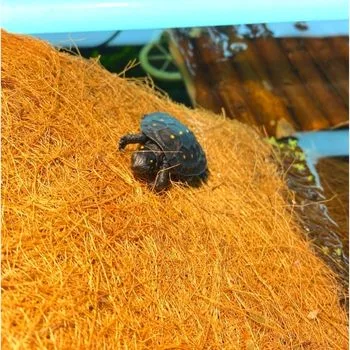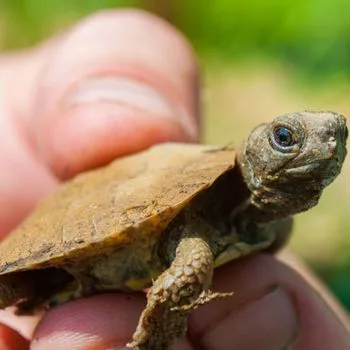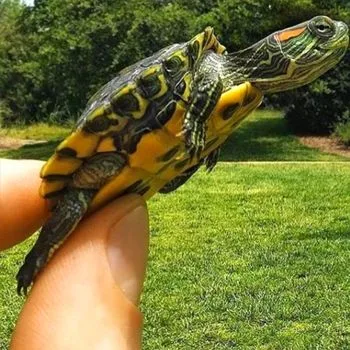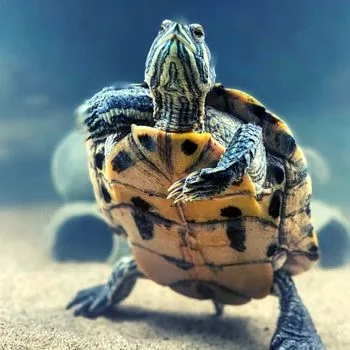The Amazing Adventures of 15 Turtles in Pennsylvania
Ah, Pennsylvania – the home of the Liberty Bell and some of the most diverse turtle populations in all of America. With 15 different species, ranging from terrestrial to aquatic to semi-aquatic, there is a lot to learn about these amazing animals.
And with several threatened or endangered turtles living here too, it’s important that we protect them so they can continue to thrive in this great state! So join us as we explore the fascinating world of Turtles in Pennsylvania!
| # | Name | Details | Image |
| 1 | Blanding Turtle (Emydoidea Blandingii) |
| 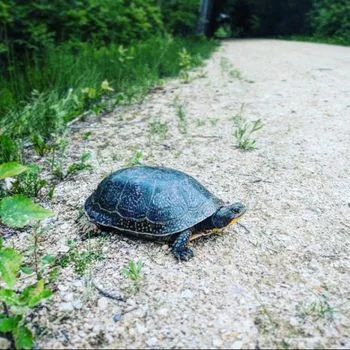 |
| 2 | Bog Turtle |
| 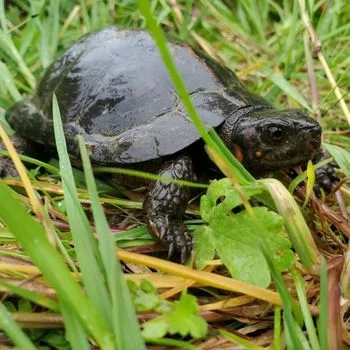 |
| 3 | Eastern Box Turtle (Terrapene Carolina) |
| 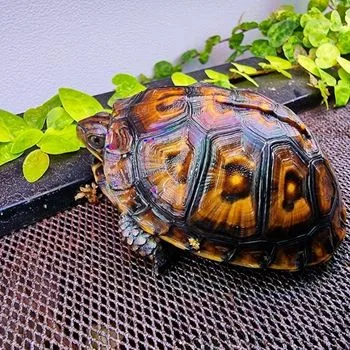 |
| 4 | Northern Red-Bellied Cooter (Pseudemys Rubriventris) |
| 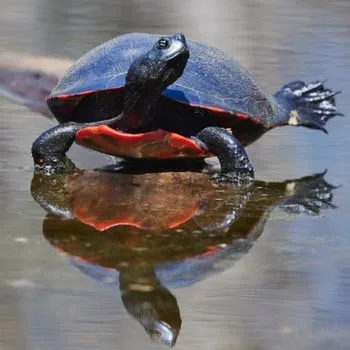 |
| 5 | Northern Map Turtle (Graptemys Geographica) |
| 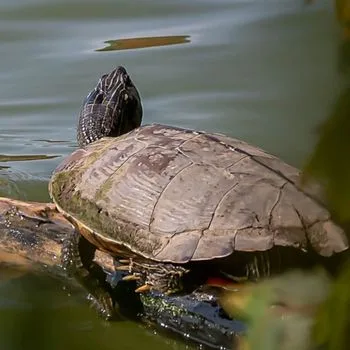 |
| 6 | Eastern Mud Turtle (Kinosternon Subrubrum) |
| 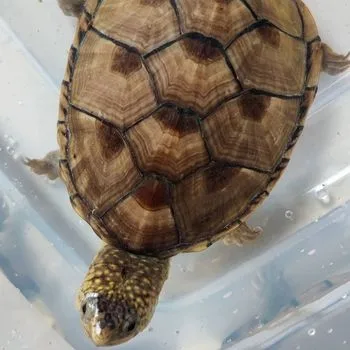 |
| 7 | Eastern Musk Turtle (Sternotherus Odoratus) |
| 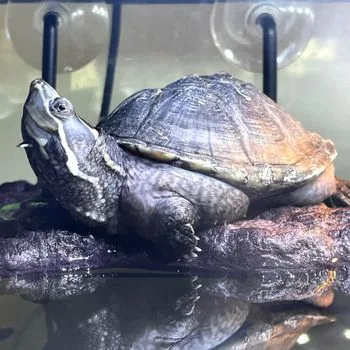 |
| 8 | Painted Turtle (Chrysemys picta) |
| 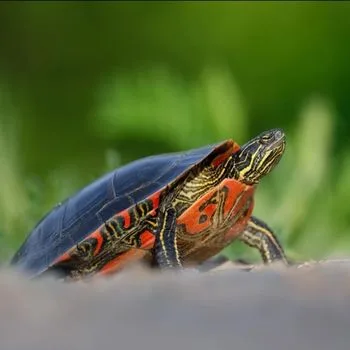 |
| 9 | Common Snapping Turtle (Chelydra serpentina) |
| 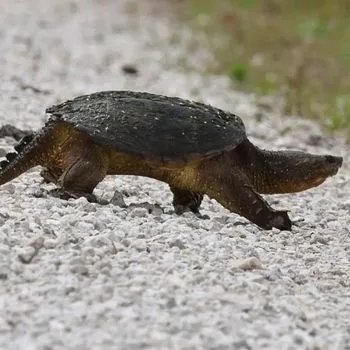 |
| 10 | Midland Smooth Softshell Turtle (Apalone mutica mutica) |
| 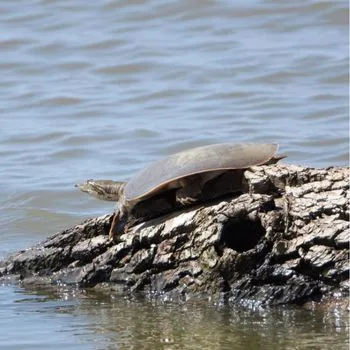 |
| 11 | Eastern Spiny Softshell Turtle (Apalone Spinifera) |
| 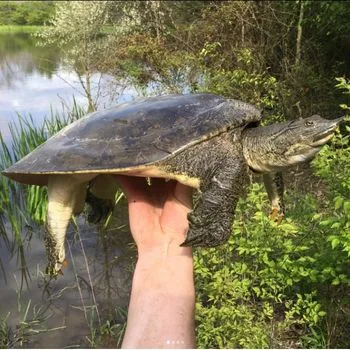 |
| 12 | Spotted Turtle (Clemmys Guttata) |
| 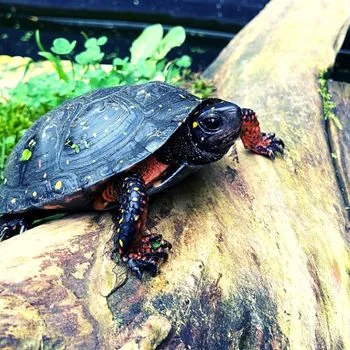 |
| 13 | Wood Turtle (Glyptemys Insculpta) |
| 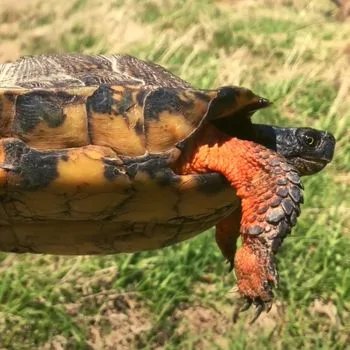 |
| 14 | Red Eared Slider (Trachemys Scripta Elegans) |
| 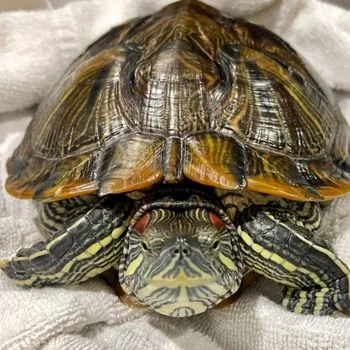 |
| 15 | Yellow-bellied Slider (Trachemys Scripta Scripta) |
| 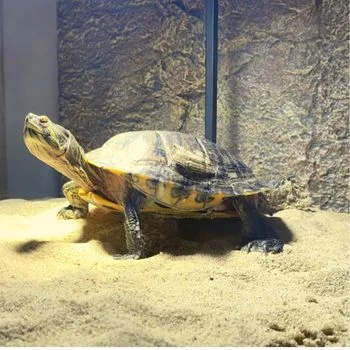 |
15 Turtles You Can Find in Pennsylvania
In total, there are 15 species of turtles in the state of Pennsylvania. This guide will take you on an exploration through each turtle type and provide tips for providing them with proper care. So, let’s get started on our journey into discovering all the wonders that these reptiles have to offer!
1. Blanding Turtle (Emydoidea Blandingii)
- Family: Emydidae
- Genus: Emydoidea
- Type: Freshwater turtle
- Natural Habitat: Marshes, swamps, ponds, and slow-moving streams in eastern north america
- Lifespan: 20-30 years
- Maximum Size: 8-10 inches in carapace length
- Maximum Weight: 1-2 pounds
- Prone to Diseases: Shell rot, respiratory infections, and skin infections
- Aggression Level: Mild
- Predators: Juveniles and eggs – raccoons, skunks, and birds; adults – large fish and otters
- Domestication: Not suitable as pets
Native to the marshes, swamps, ponds, and slow-moving streams of Eastern North America, the Blanding Turtle (Emydoidea Blandingii) is a freshwater turtle. Adults measure 8-10 inches in carapace length, and weigh around 1-2 pounds, with little variation between male and female sizes.
These turtles are mild and usually not aggressive, though juveniles and eggs can be preyed on by raccoons, skunks, and birds. Adult Blanding Turtles in Pennsylvania can be preyed on by large fish, otters, and humans.
Due to habitat loss and exploitation for the pet trade, these turtles are listed as a Species of Special Concern in some states including Maine, New York, Ohio, and Indiana. However, they are not suitable as pets as they require specialized habitats to thrive. Furthermore, if kept captive they can suffer from illnesses like shell rot or respiratory infections if not maintained properly.
Blanding Turtles are strong swimmers well adapted to life in the water. Conservation efforts should continue in the state of Pennsylvania in order to protect this species which plays an important role in maintaining healthy ecosystems within its range from Eastern North America.
Moreover, educational initiatives should be established to educate people about the significance of protecting these turtles before their population further declines.
2. Bog Turtle
- Family: Emydidae
- Genus: Glyptemys
- Type: Terrestrial turtle
- Natural Habitat: Wetlands, bogs, and swamps
- Lifespan: 20-30 years
- Maximum Size: 4-5 inches
- Maximum Weight: 1-2 pounds
- Prone to Diseases: Parasites and fungal infections
- Aggression Level: Mildly aggressive, may bite if threatened
- Predators: Skunks, raccoons, and foxes
- Domestication: Illegal to possess without permit in most states
The Bog Turtle, or Glyptemys muhlenbergii, is a critically endangered species of turtle native to wetlands, bogs, and swamps in the Northeastern and north-central United States. With a carapace length of 4-5 inches and weighing around 1-2 pounds, there is no size variation between male and female Bog Turtles. They have a lifespan of 20-30 years.
Skunks, raccoons, foxes and humans are the main predators of these turtles as juveniles are highly vulnerable due to their small size. Unfortunately, they also face threats from exploitation for the pet trade—it is illegal to remove them from the wild and possess them without a permit in most states. Bog Turtles are not commonly kept as pets as they require special environments to thrive in captivity. In addition, these turtles tend to be mildly aggressive and may bite if threatened.
Bog Turtles are not well adapted to aquatic life; instead they prefer warm humid climates like those found in Pennsylvania. As such they face massive habitat destruction due to urbanization which has led to their listing as an Endangered Species by the Endangered Species Act in several states including New York, Pennsylvania, and Vermont.
To help protect this species it is important for conservation efforts to continue in Pennsylvania so that healthy ecosystems can be maintained throughout its range. Moreover, educational initiatives need to be established that inform people about the importance of protecting Bog Turtles before their population further declines due to the illegal collection for the pet trade and habitat loss.
3. Eastern Box Turtle (Terrapene Carolina)
- Family: Emydidae
- Genus: Terrapene
- Type: Terrestrial turtle
- Natural Habitat: Deciduous and mixed forests, meadows, and fields
- Lifespan: 60 years
- Also Known As: Eastern terrapin
- Maximum Size: 4-10 inches
- Maximum Weight: Male: 1 pounds, females: 2 pounds
- Prone to Diseases: Respiratory infections, shell rot, and other diseases
- Aggression Level: Not aggressive towards humans
- Predators: Raccoons, skunks, opossums, and snakes
- Domestication: Can be kept as pets
The Eastern Box Turtle (Terrapene Carolina) is one of the most intriguing species found in deciduous and mixed forests, meadows, and fields of eastern North America. This incredible turtle can live up to 40 years in the wild or even reach up to 60 years in captivity! With adult sizes ranging from 4-10 inches, males being slightly smaller than females with a weight of 0.5-1 lb for males and 1-2 lbs for females.
Eastern Box Turtles are not too aggressive towards humans but potential predators may include raccoons, skunks, opossums, and snakes. They can be kept as pets but it is important to consult local laws before doing so since some states make it illegal to collect wild turtles or sell them as pets—including Pennsylvania. Captive Eastern Box Turtles may be prone to respiratory infections, shell rot, and other diseases common to captive turtles.
This species is state-protected in several states due to the declining population caused by habitat loss and illegal collection for the pet trade. Despite this precarious situation, Eastern Box Turtles can still be found in eastern North America—including Pennsylvania. It is essential that we take steps to protect this species which calls Pennsylvania home by preserving their natural habitats as well as improving public awareness of their plight!
4. Northern Red-Bellied Cooter (Pseudemys Rubriventris)
- Family: Emydidae
- Genus: Pseudemys
- Type: Aquatic turtle
- Natural Habitat: Rivers, swamps, and large ponds in the eastern united states
- Lifespan: Can live up to 50 years
- Also Known As: Cooters
- Maximum Size: 10 to 13.5 inches
- Maximum Weight: 12+ pounds
- Prone to Diseases: Mucinous melanophoroma
- Aggression Level: Not aggressive
- Predators: Raccoons, humans
- Domestication: Can be kept as pet
This one is an aquatic turtle native to rivers, swamps, and large ponds in the eastern United States. They reach an average length of 8 to 11 inches with adult males being slightly smaller than females.
These turtles may be kept as pets but require a large aquarium due to their size. Despite their small appearance they are not regarded as aggressive animals so there’s no need for fear if you come across one near Pennsylvania, simply observe from a respectable distance!
Of course taking them home without permits or licenses is highly illegal – something I’m sure any red-blooded American would know already!
5. Northern Map Turtle (Graptemys Geographica)
- Family: Emydidae
- Genus: Graptemys
- Type: Aquatic turtle
- Natural Habitat: Rivers, streams, and large ponds in the northern united states
- Lifespan: 20+ years
- Also Known As: Common map turtle
- Maximum Size: Males: can reach up to 6 inches, females: can reach up to 10 inches
- Maximum Weight: Males: 150-400 gm, females: 1.5-5.5 pounds
- Prone to Diseases: Contaminants due to the diet habit
- Aggression Level: Not aggressive
- Predators: Racoons, coyotes and skunks
- Domestication: Can be kept as pet
The Northern Map Turtle (Graptemys geographica) is a species of aquatic turtle native to the rivers, streams and large ponds in the northern United States. They can reach up to 10 inches in carapace length with male size being smaller than female. Adults don’t have many natural predators but juveniles are preyed upon by birds, mammals and larger fish.
These strong swimmers have an excellent carapace for protection from danger and they can live up to 20-25 years if properly cared for! Given their beautiful markings, it’s no surprise that these turtles are becoming increasingly popular as pets – just remember they must be treated with care and may require permits depending on the state, including Pennsylvania. They’re also prone to respiratory infections when kept in captivity so it’s important to monitor them closely.
Luckily, this majestic species isn’t endangered yet – though population numbers may be decreasing rapidly in certain areas. The Northern Map Turtles can are easily found living around Illinois, Indiana, Iowa, Michigan, Minnesota, Missouri, Ohio, and Wisconsin among other US states!
6. Eastern Mud Turtle (Kinosternon Subrubrum)
- Family: Kinosternidae
- Genus: Kinosternon
- Type: Mud turtle
- Natural Habitat: Freshwater wetlands, swamps, and slow-moving streams
- Lifespan: 30 years
- Maximum Size: 5 inches
- Maximum Weight: 9.27 ounces
- Aggression Level: Low
- Predators: Raccoons, snakes, and birds of prey
- Domestication: Not suitable as a pet
The Eastern Mud Turtle (Kinosternon subrubrum) is a small freshwater turtle found in the southeastern United States, including Pennsylvania. This species of turtle is known for its highly aquatic adaptations and webbed feet, which make it well-suited to life in slow-moving streams, swamps, and wetlands. The Eastern Mud Turtle can reach up to 5 inches in length and has a maximum weight of 9.27 ounces. It is not aggressive, but may bite if provoked—so exercise caution when near any wild turtles!
The diet of the Eastern Mud Turtle consists primarily of aquatic invertebrates such as snails, worms, and insects. They are also opportunistic scavengers, meaning they will take advantage of carrion when available. Predators of this species include raccoons, snakes, and birds of prey. The lifespan of these turtles is up to 30 years in the wild and due to their abundance across the southeastern United States are not listed as threatened or endangered.
Although they do not make suitable pets due to their size and temperament being unsuitable for captivity, taking care to observe local wildlife regulations is important when interacting with wild Eastern Mud Turtles in Pennsylvania . Taking steps such as preserving their natural habitats helps protect this species from destruction or poaching—ensuring they remain an iconic part of our environment for many more years to come!
7. Eastern Musk Turtle (Sternotherus Odoratus)
- Family: Kinosternidae
- Genus: Sternotherus
- Type: Semi-aquatic turtle
- Natural Habitat: Freshwater habitats, including rivers, lakes, and swamps
- Lifespan: 20 to 30 years
- Maximum Size: 5.5 inches
- Maximum Weight: 11.22 ounces
- Prone to Diseases: Shell rot, respiratory infections, etc.
- Aggression Level: Generally docile and not aggressive
- Predators: Raccoons, skunks, and birds of prey
- Domestication: Can be kept as pets
The Eastern Musk Turtle (Sternotherus odoratus) is a semi-aquatic species of turtle found in many freshwater habitats across the southeastern United States, including states such as Florida, Georgia, South Carolina, North Carolina, Tennessee, Virginia, West Virginia, Kentucky, Ohio, Pennsylvania, New York and New Jersey.
These turtles are generally quite docile and not aggressive. They can reach a shell length of up to 5.5 inches with males being typically smaller than females and will weigh around 11.22 ounces when fully grown.
These turtles are well adapted to life in the water thanks to their webbed feet which helps them to swim gracefully in their aquatic homes. They can even be kept as pets if you have the correct enclosure and diet set up for them; however regulations in Pennsylvania may vary so double-check before taking on an Eastern Musk Turtle as a pet.
Eastern Musk Turtles prey on small invertebrates living close to the water’s surface or small fish from time to time; however they too are preyed upon by animals such as raccoons and birds of prey looking for an easy meal! If given proper care these turtles can live up to 30 years old although illnesses like shell rot or respiratory infections can occur if not cared for correctly.
It’s important that we take steps towards preserving their natural habitats and increasing public awareness about this species that calls Pennsylvania home!
8. Painted Turtle (Chrysemys picta)
- Family: Emydidae
- Genus: Chrysemys
- Type: Aquatic turtle
- Natural Habitat: Rivers, streams, and large ponds in the northern united states
- Lifespan: 20 – 30 years
- Maximum Size: Males: can reach up to 5.5 – 6 inches, females: 5 – 10 inches
- Maximum Weight: Males: roughly 300 gm, females: on avg 500 gm
- Prone to Diseases: Shell infections
- Disease Carrier: Salmonella
- Aggression Level: Not aggressive
- Predators: Raccoons, skunks, foxes, herons, other birds, snakes, and large predaceous fish
Have you ever wanted to own a beautiful and unique pet? The Painted Turtle (Chrysemys picta) may just be the perfect fit for you!
Native to North America, this semi-aquatic reptile lives in Pennsylvania’s rivers, lakes, marshes and ponds. The carapace length of these turtles ranges from 4-10 inches long with females being larger than males.
With proper care and clean living conditions, they have an average lifespan of 20-30 years – making them great companion animals for your family or even as solo pets. Just make sure to check what regulations there are in Pennsylvania so that you can give your pet painted turtle the best life possible!
9. Common Snapping Turtle (Chelydra serpentina)
- Family: Chelydridae
- Genus: Chelydra
- Type: Freshwater turtle
- Natural Habitat: Freshwater habitats such as lakes, rivers, and swamps
- Lifespan: 50 years
- Maximum Size: 19 inches
- Maximum Weight: 40 pounds
- Prone to Diseases: Fungal infections and shell rot
- Aggression Level: Not aggressive until provoked
- Predators: River otters, bears and coyotes
- Domestication: Not recommended as pets
The Common Snapping Turtle, scientifically known as Chelydra serpentina, is an aquatic species native to freshwater habitats such as lakes, rivers and swamps. These turtles are highly adaptable and can live up to 50 years in the wild.
Adult Common Snapping Turtles typically measure 10-16 inches in shell length but can grow up to 19 inches and weigh around 40 pounds. They have a powerful bite with an estimated pressure of over 600 psi, making them one of the strongest biters among reptiles. Despite their strength they are generally not aggressive animals, though it is best to not provoke them and take caution around them.
Common Snapping Turtles often face threats from predators such as river otters, bears and coyotes when living out in the wild.
Unfortunately, their habitat is also threatened by human activities such as development and pollution which can lead to a decrease in population numbers if conservation efforts are not taken soon here in Pennsylvania.
Although they make fascinating pets due to their long lifespan of up to 50 years when cared for properly, some states have regulations or restrictions on owning them so check with local authorities before acquiring this species as a pet.
These turtles have webbed feet for swimming and a long tail for propulsion allowing them to move quickly through water which also makes them difficult prey for predators.
Furthermore, although they occupy multiple states across North America from Alabama to Wyoming there is no other name than the Common Snapping Turtle so it’s easy to identify.
It should be noted that this species does not carry any significant disease that can be transmitted to humans yet they may still be prone to diseases like fungal infections or shell rot when kept in unsanitary conditions so proper care must be taken here in Pennsylvania when considering owning one of these remarkable creatures as a pet.
10. Midland Smooth Softshell Turtle (Apalone mutica mutica)
- Family: Trionychidae
- Genus: Apalone
- Type: Freshwater turtle
- Natural Habitat: Slow-moving streams, rivers, lakes, and ponds in the midwestern and southeastern united states
- Lifespan: 25-30 years
- Maximum Size: 10 inches
- Prone to Diseases: Shell rot and respiratory infections
- Aggression Level: Mild, non-aggressive species
- Predators: Alligators, large fish, and snapping turtles
- Domestication: Can be kept in captivity
Native to the midwestern and southeastern United States, including Pennsylvania, the Midland Smooth Softshell Turtle (Apalone mutica mutica) is a majestic freshwater species.
With adults typically reaching 7-8 inches in length and some individuals even reaching up to 10 inches, these turtles weigh an average of 1-4 pounds with no significant size variations between males and females. They can be found in slow-moving streams, rivers, lakes, and ponds and display mild, non-aggressive behavior.
Despite not being commonly kept as pets, if taken into captivity they require proper care such as providing a balanced diet and a clean environment. Furthermore, they may be vulnerable to shell rot and respiratory infections if kept in unclean or poorly ventilated environments. Predation from alligators, large fish, birds of prey or raccoons may occur whilst eggs and hatchlings are prone to predation from skunks or other predators.
Although not currently listed as endangered by IUCN standards – populations of Midland Smooth Softshell Turtles may be declining due to habitat loss and collection for the pet trade.
These aquatic creatures are also found in Arkansas, Illinois, Indiana, Iowa, Kansas, Kentucky, Louisiana, Missouri , Mississippi , Ohio , Oklahoma , Tennessee ,and Texas. Respectful caution should also be taken when spotting a Midland Smooth Softshell Turtle since although rarely aggressive towards humans – they are still considered vulnerable according to IUCN standards and hence should not be disturbed needlessly even if encountered in nature during your visit at Pennsylvania.
11. Eastern Spiny Softshell Turtle (Apalone Spinifera)
- Family: Trionychidae
- Genus: Apalone
- Type: Freshwater turtle
- Natural Habitat: Slow-moving rivers, streams, ponds, and lakes with soft bottoms and abundant aquatic vegetation
- Lifespan: 30 to 40 years
- Maximum Size: 18 inches
- Maximum Weight: 12 lbs
- Prone to Diseases: Respiratory infections, shell rot, and pneumonia
- Aggression Level: Not aggressive, but will bite if threatened
- Predators: Raccoons, alligators, snapping turtles, otters, and larger fish
- Domestication: Not commonly kept as pets
The Eastern Spiny Softshell Turtle (Apalone Spinifera) is an incredible species of freshwater turtle found throughout Pennsylvania. With powerful legs for swimming and a streamlined shell, this impressive creature has adapted to its aquatic environment over millennia. Adults measure between 8-18 inches with males being smaller at 8-12 inches compared to10-18 inches for females, weighing from 4-12lbs respectively. Despite their small size they are surprisingly strong and have a bite force that can put unsuspecting predators on their guard!
Yet these turtles aren’t all aggression; they’re also known to be quite timid and shy when humans appear near them, preferring the safety of rivers, streams or lakes – where plenty of vegetation exists in soft bottomed areas – as habitats. Unfortunately however some populations have declined due to habitat loss or collection for pets so it’s important we do everything in our power to protect these creatures and maintain a healthy ecosystem here in Pennsylvania!
12. Spotted Turtle (Clemmys Guttata)
- Family: Emydinae rafinesque
- Genus: Clemmys
- Type: Semi-aquatic turtle
- Natural Habitat: Marshy meadows, ponds, ditches, bogs, swamps, etc. as small bodies of still water.
- Lifespan: 60 – 100+ years
- Maximum Size: 4 – 5 inches
- Maximum Weight: 0.5 to 1 pound
- Prone to Diseases: Vitamin a deficiency, respiratory diseases, abscesses, shell infections and fractures, and parasites
- Disease Carrier: Salmonella
- Aggression Level: Coexisting is possible for spotted turtles, but housing male individuals together may lead to aggression.
- Predators: Mammals, such as raccoons, muskrats, birds and large fishes.
- Domestication: Can be kept as pets
Introducing the Spotted Turtle (Clemmys Guttata)! This small, terrestrial and aquatic turtle is native to the eastern United States from Maine down to Pennsylvania. Adults grow up to 4-5 inches in carapace length, with a weight ranging between half a pound and one pound. Juveniles can measure between 1-3 inches when they hatch.
These animals are quite hardy creatures who generally live peaceably amongst their own kind; however, under threat they may become somewhat aggressive. There are several predators that hunt them such as raccoons, skunks, snakes and birds of prey in this area.
Despite being only mildly domesticated creatures it is possible for these turtles to be kept as pets with specialized care. Prone illnesses include respiratory infections and shell rot – but fortunately this species does not act as a disease carrier itself!
13. Wood Turtle (Glyptemys Insculpta)
- Family: Emydidae
- Genus: Glyptemys
- Type: Semi-aquatic turtle
- Natural Habitat: They prefer to sleep in streams surrounded by forests during the winter but venture out to grasslands, barren areas, and sandy shores for food and nesting during the spring.
- Lifespan: 12+ years
- Maximum Size: 6 to 10 inches
- Maximum Weight: 0.5 – 2 pounds
- Prone to Diseases: Selenosis, metabolic disease
- Disease Carrier: Salmonella
- Aggression Level: Not aggressive
- Predators: Raccoons, coyotes, and foxes, arious mammals, fishes, and birds prey
- Domestication: Can be kept as pet if collected from a collector
The wood turtle (Glyptemys insculpta) is a semi-aquatic species of reptile native to Eastern North America, ranging from Nova Scotia to West Virginia. It is distinguishable by its dark coloring, with yellowish and orange markings across the shell that can even become brighter in the sun.
Typically measuring between 6 – 10 inches and weighing half a pound up to two pounds, the wood turtle that inhabits Pennsylvania is both an impressive sight and hardy survivor.
Found mainly near forests where it spends winters asleep in streams, these turtles often venture into grasslands or sandy shores for food during the spring months. Wood turtles aren’t typically aggressive but must still beware as raccoons, coyotes and foxes are among their predators. They even possess a powerful bite force that allows them to break through shells!
14. Red Eared Slider (Trachemys Scripta Elegans)
- Family: Emydidae
- Genus: Trachemys
- Type: Aquatic turtle
- Natural Habitat: Streams, rivers, ponds, lakes, swamps, and marshes
- Lifespan: 20 – 30 years
- Also Known As: Red-eared terrapin
- Maximum Size: 7 – 12 inches, females get larger than 12 inches
- Maximum Weight: 3 – 6 pounds
- Prone to Diseases: Respiratory infections, shell rot, and other diseases if kept in unsanitary conditions.
- Disease Carrier: Salmonella
- Aggression Level: Not aggressive
- Predators: Raccoons, otters, fish, frogs, snakes, skunks and birds
- Domestication: Can be kept as pets
The Red Eared Slider (Trachemys scripta elegans) is a freshwater reptile with a striking appearance. Found in Pennsylvania’s waterways, these turtles can reach up to 10-12 inches long as adults and can live for an impressive 30 years. They have webbed feet that are adapted for swimming, making them incredibly agile aquatic creatures.
Males and females exhibit different size ranges, with males being more diminutive compared to the females and juveniles measuring only 2-3 inches when fully grown. Although they may take on aggressive postures if threatened, their bite force is not enough to cause any damage to humans or other larger animals.
It’s important that we respect the habitats of these amazing reptiles so that future generations will be able to enjoy them too – keep their environments clean by disposing of garbage properly and avoid disturbing the fragile ecosystems where they make their homes!
15. Yellow-bellied Slider (Trachemys Scripta Scripta)
- Family: Emididae
- Genus: Trachemys
- Type: Freshwater turtle
- Natural Habitat: Slow-moving rivers, floodplain swamps, marshes, seasonal wetlands, and permanent ponds
- Lifespan: 20-30 year
- Maximum Size: 8 – 12 inches
- Maximum Weight: Up to 3 pounds
- Disease Carrier: Salmonella
- Aggression Level: When kept in pairs, yellow-bellied slider turtles may exhibit aggression, unlike their docile behavior when housed individually.
- Predators: Raccoons (procyon lotor) and humans, who shoot them while basking, kill them on roads, and fracture shells with boat propellers. hatchlings and juveniles are eaten by large fish, some snakes, raccoons, and wading birds
Native to the southeastern United States from Florida to Virginia, the Yellow-bellied Slider (Trachemys Scripta Scripta) is a freshwater turtle. These beautifully patterned creatures have yellow shells with black patches around each scute as well as bright yellow bellies, giving them their name. They can measure up to 12 inches long and weigh up to 3 pounds.
In Pennsylvania, these turtles are found in low-moving rivers, floodplain swamps, marshes, seasonal wetlands and permanent ponds . In the wild they usually lead solitary lives and do not show aggression towards other animals unless kept in pairs when some competition may arise over certain mates.
Sadly raccoons (Procyon lotor) and humans are major threats for these vulnerable reptiles due to disturbance of their habitats or hunting them down for food or sport; juveniles also face even more trouble since they’s likely be eaten by large fish, some snakes, raccoons and wading birds if left unprotected! Conservation efforts need to be increased so that this majestic species will continue inhabiting our planet far into future generations!
Final Words
In the state of Pennsylvania—a place rich in biodiversity—turtles play a significant role; with a variety of species dwelling in its forests, beaches, and rivers.
In this article, we took a closer look at these fascinating creatures (including their natural habitats, lifespan, size and weight, predators, and domesticability). It’s worth noting that, while keeping these turtles as pets is legal; their populations in Pennsylvania may be declining due to habitat loss and collection for the pet trade.
It is our responsibility to ensure that these turtles remain protected and preserved for future generations to enjoy in the state of Pennsylvania.
Other Nearby States:
- Turtles In New York
- Turtles In Ohio
- Turtles In West Virginia
- Turtles In Delaware
- Turtles In Maryland
- Turtles In New Jersey

